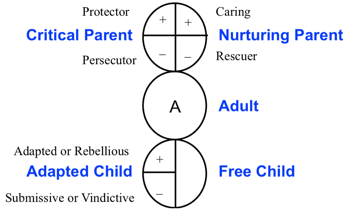According to the International Transactional Analysis Association, TA “is a theory of personality and a systematic psychotherapy for personal growth and personal change.” As a theory of personality, TA describes how people are structured psychologically. It uses what is perhaps its best-known model, the ego-state (Parent-Adult-Child) model.
Transactional analysis integrates the theories of psychology and psychotherapy because it has elements of psychoanalytic, humanist and cognitive ideas.
As shown in the picture, TA is based on 3 principles:
- We all have three ‘ego states’ (Parent, Adult, and Child)
- We all have transactions (with other people, or internally with ourselves)
- We all (unconsciously) activate our ego states in our transactions, which can lead to conflict, negative emotions, pain, etc.
According to the PAC model (Parent Adult Child), we all have the 3 states and when we interact with others there might be multiple transactions in place. The ideal way and the most conscious way of interaction is of course adult – adult. Described in Thomas A. Harris book “I’m ok you’re ok”. When both parties interact from a basis of I’m ok you’re ok, having the capacity of self-reflection and reflection in the system, adult – adult would be the most desirable relationship in the workplace.
Here some quotes from the book
https://www.goodreads.com/book/show/134353.I_m_OK_You_re_OK
Basically, transactional analysis is about identifying which ego states are present in our transactions so that we can become more conscious of our thoughts and behaviors, and ultimately have better, more constructive transactions with the people around us.
Based on individual developmental states, not all interactions can be adult – adult. When people interact from Parent or Child states many dynamics will show up. If two parties can find a symbiosis, then there can be a harmonious transaction. Although unhealthy, there will be no conflict. Conflicts happen when we’re in cross sections, e.g. if one person acts on the parent state and the other person acts from adult state, then per se there cannot be a symbiosis.
Now let’s look at some of those conflict situations. In the Parent state, there can be positive or negative side, a critical parent or a nurturing parent. Depending on the situation, the critical parent can become protective or become a prosecutor role. The nurturing parent can either showing caring traits or play a rescuer role.
In the Child state, there is adapted child or free child. The adapted child state then has rebellious vs. submissive.
An example of a symbiosis can be: if one person takes the nurturing parent role and the other person submissive child role. Then both have what they need in their ego state and if there is no disruption or growth then they can maintain a harmonious transaction. Another interesting example is if one person takes critical parent role and the other person rebellious child role. Then there is also a symbiosis, just not a peaceful one. But if both sides don’t grow out of their states then even if the symbiosis is damaging, it can still be a prolonged transaction.
If we find ourselves activate one particular state in the majority of time, then this could be a sign for deeper reflection. The ideal transaction is when both parties act out of the adult – adult role.
When we’re in the middle of a crossed transaction, the only way to get it back to a constructive place is for one, or both parties, to shift ego states. Usually, it’s best to shift (or try very very hard to shift) to the Adult state. However, it can vary. We need to be attuned to what’s actually happening in a conversation and the needs of each person (hard to do, but possible with practice, or coaching and mediation).
An interesting challenge I feel is, what if one person has strong tendency of either Parent state or Child state but not aware of adult state? To maintain a healthy system, the ideal way would be bringing awareness to the adult state. The concept that “I’m ok, you’re ok” is a long-term and sustainable transaction. In the workplace, there is a normally a bigger system around each individual transaction. So it is here that the art and craft of an OD practitioner need to come in place. To have the awareness and courage to bring hidden dynamics onto the table; to show leadership in recognizing what transactions are in place in any given moment; and to encourage all parties in the system to be mindful of the transactions that are taking place.
Back to my favorite Teal topic, in my view there are 3 things must be in place when setting up a self-organized system, aside from purpose and all the rest of it.
These 3 things are: the clarity of roles, the agreed decision-making process and the agreed and transparent conflict resolution mechanism. Often times I see teams overlooking conflict resolution as they have the passion and purpose to move on. However, without such clarity, the risk would be people tend to avoid highlighting tension, especially in teams that cherish harmony. This tendency can be detrimental when there is a conflict in the system, either people are not aware of it or not willingly addressing it.
For me personally, learning never stops. What would be the best way to develop empathy in a certain type of situation? Experiencing it myself:) And when we do find ourselves in such situations, I feel this is the test of being mindful. First having the awareness of our own state of being entering into a transaction; then develop the empathy of the system setting and everyone in the system. Moving towards a common understanding of what’s best for the system, cultivate awareness and willingness to address the different TA states.
Perhaps more thoughts coming in the next blog?


